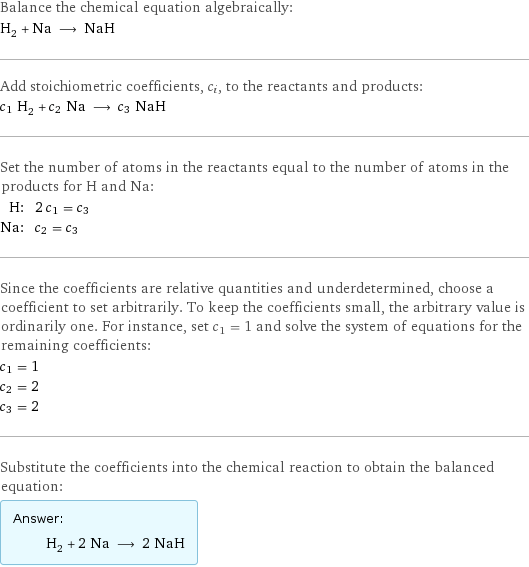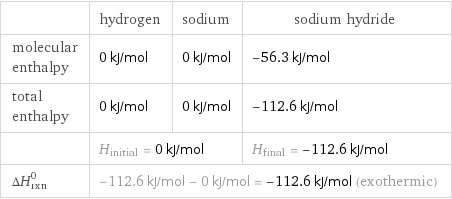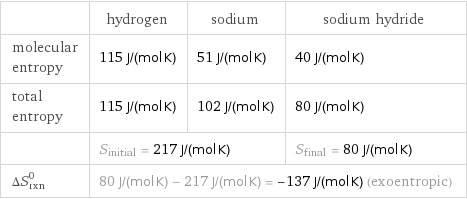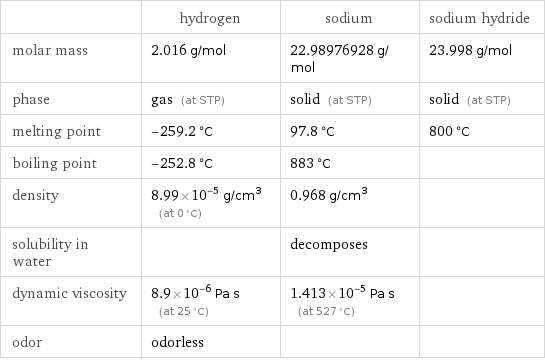Input interpretation

H_2 (hydrogen) + Na (sodium) ⟶ NaH (sodium hydride)
Balanced equation

Balance the chemical equation algebraically: H_2 + Na ⟶ NaH Add stoichiometric coefficients, c_i, to the reactants and products: c_1 H_2 + c_2 Na ⟶ c_3 NaH Set the number of atoms in the reactants equal to the number of atoms in the products for H and Na: H: | 2 c_1 = c_3 Na: | c_2 = c_3 Since the coefficients are relative quantities and underdetermined, choose a coefficient to set arbitrarily. To keep the coefficients small, the arbitrary value is ordinarily one. For instance, set c_1 = 1 and solve the system of equations for the remaining coefficients: c_1 = 1 c_2 = 2 c_3 = 2 Substitute the coefficients into the chemical reaction to obtain the balanced equation: Answer: | | H_2 + 2 Na ⟶ 2 NaH
Structures

+ ⟶
Names

hydrogen + sodium ⟶ sodium hydride
Reaction thermodynamics
Enthalpy

| hydrogen | sodium | sodium hydride molecular enthalpy | 0 kJ/mol | 0 kJ/mol | -56.3 kJ/mol total enthalpy | 0 kJ/mol | 0 kJ/mol | -112.6 kJ/mol | H_initial = 0 kJ/mol | | H_final = -112.6 kJ/mol ΔH_rxn^0 | -112.6 kJ/mol - 0 kJ/mol = -112.6 kJ/mol (exothermic) | |
Entropy

| hydrogen | sodium | sodium hydride molecular entropy | 115 J/(mol K) | 51 J/(mol K) | 40 J/(mol K) total entropy | 115 J/(mol K) | 102 J/(mol K) | 80 J/(mol K) | S_initial = 217 J/(mol K) | | S_final = 80 J/(mol K) ΔS_rxn^0 | 80 J/(mol K) - 217 J/(mol K) = -137 J/(mol K) (exoentropic) | |
Equilibrium constant
![Construct the equilibrium constant, K, expression for: H_2 + Na ⟶ NaH Plan: • Balance the chemical equation. • Determine the stoichiometric numbers. • Assemble the activity expression for each chemical species. • Use the activity expressions to build the equilibrium constant expression. Write the balanced chemical equation: H_2 + 2 Na ⟶ 2 NaH Assign stoichiometric numbers, ν_i, using the stoichiometric coefficients, c_i, from the balanced chemical equation in the following manner: ν_i = -c_i for reactants and ν_i = c_i for products: chemical species | c_i | ν_i H_2 | 1 | -1 Na | 2 | -2 NaH | 2 | 2 Assemble the activity expressions accounting for the state of matter and ν_i: chemical species | c_i | ν_i | activity expression H_2 | 1 | -1 | ([H2])^(-1) Na | 2 | -2 | ([Na])^(-2) NaH | 2 | 2 | ([NaH])^2 The equilibrium constant symbol in the concentration basis is: K_c Mulitply the activity expressions to arrive at the K_c expression: Answer: | | K_c = ([H2])^(-1) ([Na])^(-2) ([NaH])^2 = ([NaH])^2/([H2] ([Na])^2)](../image_source/58c452238938d51d2d683eea3b49ad32.png)
Construct the equilibrium constant, K, expression for: H_2 + Na ⟶ NaH Plan: • Balance the chemical equation. • Determine the stoichiometric numbers. • Assemble the activity expression for each chemical species. • Use the activity expressions to build the equilibrium constant expression. Write the balanced chemical equation: H_2 + 2 Na ⟶ 2 NaH Assign stoichiometric numbers, ν_i, using the stoichiometric coefficients, c_i, from the balanced chemical equation in the following manner: ν_i = -c_i for reactants and ν_i = c_i for products: chemical species | c_i | ν_i H_2 | 1 | -1 Na | 2 | -2 NaH | 2 | 2 Assemble the activity expressions accounting for the state of matter and ν_i: chemical species | c_i | ν_i | activity expression H_2 | 1 | -1 | ([H2])^(-1) Na | 2 | -2 | ([Na])^(-2) NaH | 2 | 2 | ([NaH])^2 The equilibrium constant symbol in the concentration basis is: K_c Mulitply the activity expressions to arrive at the K_c expression: Answer: | | K_c = ([H2])^(-1) ([Na])^(-2) ([NaH])^2 = ([NaH])^2/([H2] ([Na])^2)
Rate of reaction
![Construct the rate of reaction expression for: H_2 + Na ⟶ NaH Plan: • Balance the chemical equation. • Determine the stoichiometric numbers. • Assemble the rate term for each chemical species. • Write the rate of reaction expression. Write the balanced chemical equation: H_2 + 2 Na ⟶ 2 NaH Assign stoichiometric numbers, ν_i, using the stoichiometric coefficients, c_i, from the balanced chemical equation in the following manner: ν_i = -c_i for reactants and ν_i = c_i for products: chemical species | c_i | ν_i H_2 | 1 | -1 Na | 2 | -2 NaH | 2 | 2 The rate term for each chemical species, B_i, is 1/ν_i(Δ[B_i])/(Δt) where [B_i] is the amount concentration and t is time: chemical species | c_i | ν_i | rate term H_2 | 1 | -1 | -(Δ[H2])/(Δt) Na | 2 | -2 | -1/2 (Δ[Na])/(Δt) NaH | 2 | 2 | 1/2 (Δ[NaH])/(Δt) (for infinitesimal rate of change, replace Δ with d) Set the rate terms equal to each other to arrive at the rate expression: Answer: | | rate = -(Δ[H2])/(Δt) = -1/2 (Δ[Na])/(Δt) = 1/2 (Δ[NaH])/(Δt) (assuming constant volume and no accumulation of intermediates or side products)](../image_source/66941448f7d423386d88df64e7a0be86.png)
Construct the rate of reaction expression for: H_2 + Na ⟶ NaH Plan: • Balance the chemical equation. • Determine the stoichiometric numbers. • Assemble the rate term for each chemical species. • Write the rate of reaction expression. Write the balanced chemical equation: H_2 + 2 Na ⟶ 2 NaH Assign stoichiometric numbers, ν_i, using the stoichiometric coefficients, c_i, from the balanced chemical equation in the following manner: ν_i = -c_i for reactants and ν_i = c_i for products: chemical species | c_i | ν_i H_2 | 1 | -1 Na | 2 | -2 NaH | 2 | 2 The rate term for each chemical species, B_i, is 1/ν_i(Δ[B_i])/(Δt) where [B_i] is the amount concentration and t is time: chemical species | c_i | ν_i | rate term H_2 | 1 | -1 | -(Δ[H2])/(Δt) Na | 2 | -2 | -1/2 (Δ[Na])/(Δt) NaH | 2 | 2 | 1/2 (Δ[NaH])/(Δt) (for infinitesimal rate of change, replace Δ with d) Set the rate terms equal to each other to arrive at the rate expression: Answer: | | rate = -(Δ[H2])/(Δt) = -1/2 (Δ[Na])/(Δt) = 1/2 (Δ[NaH])/(Δt) (assuming constant volume and no accumulation of intermediates or side products)
Chemical names and formulas

| hydrogen | sodium | sodium hydride formula | H_2 | Na | NaH Hill formula | H_2 | Na | HNa name | hydrogen | sodium | sodium hydride IUPAC name | molecular hydrogen | sodium | sodium hydride
Substance properties

| hydrogen | sodium | sodium hydride molar mass | 2.016 g/mol | 22.98976928 g/mol | 23.998 g/mol phase | gas (at STP) | solid (at STP) | solid (at STP) melting point | -259.2 °C | 97.8 °C | 800 °C boiling point | -252.8 °C | 883 °C | density | 8.99×10^-5 g/cm^3 (at 0 °C) | 0.968 g/cm^3 | solubility in water | | decomposes | dynamic viscosity | 8.9×10^-6 Pa s (at 25 °C) | 1.413×10^-5 Pa s (at 527 °C) | odor | odorless | |
Units
